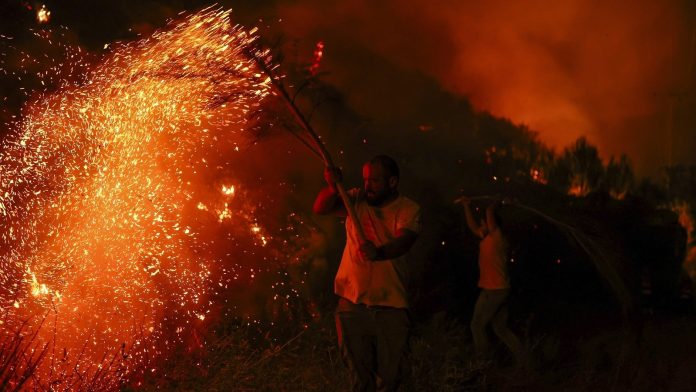Europe’s Blaze: Wildfires Rage Amidst a Searing Heatwave
In the simmering heart of summer 2024, Europe is blazing—not with the vibrant glow of cultural festivals or sun-drenched holidays, but with the grim, relentless firestorms consuming its Mediterranean landscapes. From the rugged coastline of Spain to the rugged hills of Turkey, firefighters and communities are caught in a fierce battle against wildfires fueled by a heatwave pushing mercury above 40°C.
As many of us sip iced drinks or seek shade during warm summer days, for thousands across southern Europe, the natural world is transforming into an unforgiving furnace. This isn’t just another hot summer — it is a vivid, alarming testament to a climate in turmoil.
A Symphony of Flames Spanning Nations
Imagine the serene beaches near Tarifa in southern Spain suddenly overshadowed by billowing clouds of black smoke, the signature whitewashed villas standing in stark contrast to the predator flames creeping in the distance. More than 2,000 people fled the area as fires, sparked in eucalyptus and pine forests, devoured hillsides and threatened homes. Helicopters, harnessing seawater in a desperate aerial ballet, poured torrents from the sky in a fight against shrinking time.
On the outskirts of Madrid, tragedy struck when a man working at a horse stable was killed as fire reached farms and homes. With temperatures forecasted to soar to 44°C in regions of Spain, the meteorological service AEMET warned of the dangerous cocktail of minimal rainfall and wind — perfect conditions that feed the fire’s ravenous hunger.
Spain’s Castile and León region alone fought 32 distinct wildfire fronts with over 1,200 firefighters engaged. Military forces have been mobilized — nearly a thousand troops aiding the inferno’s containment — as villages were evacuated, their residents exiled before the flames. “It’s like we’re being cooked alive,” lamented Alexandre Favaios, mayor of a northern Portuguese town where fires had raged for over ten grueling days. “Our people are in panic — we do not know when the fire will finally knock on our doors.”
Mediterranean’s Fiery Pulse
But Spain is just one chapter in a regional saga. Portugal’s northern regions, battling vast forest fires near Vila Real, unveil the intense human toll and logistical challenges. Two vital Portuguese waterbombing planes were grounded, forcing an urgent request for assistance — Morocco swiftly supplied replacement aircraft, showing an extraordinary neighborly resilience.
In the Balkans, Albania, Montenegro, and neighboring countries contend with their own scorching ordeal. From Albania’s forests turned to ash and farmland charred black, multinational helicopter squads from the Czech Republic, Slovakia, and even the UAE assisted in taming infernos fed by relentless winds. Near Montenegro’s capital, Podgorica, the blaze thickened the air with smoke, while tragedy cast a shadow when a firefighter convoy overturned, claiming a soldier’s life and leaving another gravely injured.
“There is a profound loss here, and the wounds go deeper than just the land,” a local Montenegrin firefighter told me. “Every ember reminds us of what we risk: not just homes, but our way of life.”
Greece and Turkey: Embers from the Edge
Further south, Greece’s Ionian islands of Zakynthos and Cephalonia witnessed strong winds turning embers into uncontrollable monsters, forcing the evacuation of villages and even a tourist hotel. “The wind is relentless, the blaze out of control,” the mayor of Zakynthos, Yiorgos Stasinopoulos, said with palpable urgency, his voice cutting through the crackling backdrop.
Meanwhile, Turkey’s northwest province of Çanakkale experienced days of relentless flames, disrupting life by closing regional airports and critical straits, vital arteries of commerce and culture. Fires near city centers and historic waterways symbolized how the inferno threatens not only nature but heritage and economy alike.
Heatwaves That Sear Beyond Flames
The heatwave wrapping Europe in a cruel embrace extends far beyond immediate fire zones. Germany sweats under heat warnings as temperatures hover above 30°C, while Italy announced red alerts for 16 cities, and France swooned under a mosaic of red and orange warnings.
In the UK, the heat health warnings issued across England sounded an ominous note about the deadly implications of rising temperatures for human health—especially for vulnerable populations. The UK Health Security Agency’s amber alerts remind us how climate events ripple out, intertwining environmental disaster with public health crises.
Curiously, Ireland stands almost as the anomaly in this unfolding drama. With more temperate highs of 22 to 28°C and looming thunderstorms in some counties, it has escaped the worst of the heatwaves. Yet even here, the atmosphere hints at disruption—nature’s unexpected rhythm unsettling the expected climate pattern.
Behind the Flames: Climate, Community, and Crisis
What we witness is no natural accident but a prelude to the future scientists have long warned about. The Mediterranean basin, with its unique climate and ecology, is heating faster than many other regions. Research shows how hotter, drier summers create tinderbox conditions, turning once-manageable fires into devastating whirlwinds of flame.
“These wildfires are not just environmental events; they are social tragedies,” notes Dr. Elena Marinakis, a climate and disaster resilience expert based in Athens. “They expose vulnerabilities—economic, infrastructural, and human—and reveal the urgent need for adaptation, mitigation, and solidarity across borders.”
Indeed, the multinational response—aircraft from Morocco aiding Portugal, Balkan countries sharing firefighting helicopters, European armies deployed to hotspots—signals a recognition that climate crises ignore lines on maps. The region’s flames, while fierce, have kindled a spirit of cooperation amidst adversity.
What Will It Take to Change the Fire’s Course?
Yet for many affected, assistance sometimes feels painfully slow or insufficient. “We need proactive plans, not just reactive help,” says Favaios, the Portuguese mayor. “More investment in forest management, better early-warning systems, and real climate action to stop these summers from becoming hellish cycles.”
And although firefighting forces valiantly confront the infernos, questions linger: How sustainable are these battles when the fire seasons grow longer and fiercer each year? How do we protect not only forests and farms but the spirit of communities that live beside them?
Dear reader, consider this: as we scroll through photos of distant wildfires or hear alarming news reports, what does it truly mean for a place to be “on fire”? These wildfires consume more than land; they burn our collective sense of security, challenge our relationship with nature, and underscore a global reckoning with climate change.
As the embers smolder and rains promise temporary relief, Europe’s firebound summer asks us all—what role will we play in the unfolding story of our planet’s future? Will we face the heat with courage, compassion, and unity?
In Closing: A Continent Tested by Fire and Heat
The summer of 2024 will not be forgotten for its festivals or sunshine but for the trials of fire and heat that tested the mettle of people and places across Europe. From the coasts of Spain to the hills of Montenegro, from the islands of Greece to the fields of Portugal, the story is the same—a narrative of fierce flames, human courage, undeniable loss, and the urgent call for change.
As firefighters work tirelessly, helicopters carve arcs in smoky skies, and communities brace against an uncertain future, this is more than a news event—it is a living, breathing challenge to how we live with our world. Let us listen, learn, and act, before the flames draw closer still.










